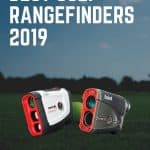Rangefinders are quickly becoming essential equipment for every golfer that doesn’t have a caddie with them to get yardages. With the rules recently changing to allow them in competition play (unless the tournament specifically says no), rangefinders use is only going to increase.
Rangefinders can be an extremely useful accessory on the golf course for a number of different reasons. They can give you certainty with your distance estimate which helps you be more confident and make an aggressive swing without worry. A rangefinder can also speed up play. It’s a lot faster to point it at a pin or other landmark than it is to pace off the distance from the nearest sprinkler head.
But knowing which is the best golf rangefinder can be tricky. So we compiled a list of the best rangefinders in various categories that are on the market today.
Contents
- Best Overall (Bushnell Pro X2)
- Best For Shaky Hands (Nikon COOLSHOT PRO Stabilized)
- Best Budget Option (Precision Pro Golf Nexus Laser Rangefinder)
- Runner Up (Bushnell Tour V4 Laser Rangefinder)
- Rangefinder Buying Guide

Bushnell Pro X2 Rangefinder
Best Overall
The Bushnell Pro X2 Rangefinder earned its spot as the best overall rangefinder on this list with a great combination of accuracy, ease of use, and a full feature set. This remarkable accessory utilizes some of the best technology in the industry in order to produce accurate pin seeking measurements for golfers on the course. There are five preset range settings for different types of holes and different distances.
With 6x magnification, slope technology, changeable color display for better visibility, and a waterproof metal housing, there are very few reasons not to get the Bushnell Pro X2. The only negative here is the expensive price range for this high quality rangefinder. If budget is not a concern then you really don’t need to look any further.
Not to worry, if this top of the line rangefinder is out of your price range, check out the rangefinder that earned the best budget selection.
Pros
- High Quality Durable Design
- Respected Golf Brand
- Full Feature Set
Cons
- Top End Price Range
- No Stabilization

Nikon COOLSHOT PRO Stabilized
Great For Golfers With Shaky Hands
The Nikon COOLSHOT PRO Stabilized rangefinder is our pick for this somewhat unique category for golfers with shaky hands. If you’re in that group then you know how frustrating it can be to use a rangefinder. This rangefinder takes advantage of stabilization technology that provides additional control for golfers that struggle to pinpoint a target through the lens.
Not only is the lens stabilized, but so is the laser that is fired to measure your target. That makes it much easier to acquire your target. Nikon is a well known company with a long history of quality optics. The stabilization technology is something that they have developed for many of their devices such as their extensive camera lineup, so it is tried and tested.
Even golfers without shaky hands should consider taking a look at this option. If you are trying to use your rangefinder to check the pin on a par 5 that may be 500+ yards away so you can aim for the best layup yardage, then even the steadiest of hands can have trouble acquiring a target.
Pros
- Stabilization Technology
- Accurate Measurements
- Slope Technology
Cons
- Expensive Price Range
- Less Rugged Than The Bushnell
Precision Pro Golf Nexus Laser Rangefinder
Best Budget Option
The Precision Pro Golf Nexus Laser Rangefinder is a good option at a price that is much easier to accept. Precision Pro has an outstanding track record in the rangefinder industry and customers have continued to show interest towards this particular rangefinder due to its significantly lower price than similar products on the market.
Despite the low price, the Nexus boasts accuracy of +/-1 yard. For all but the highest level players, this is really all that is necessary.
One feature that stands out is the pulse vibration that goes into effect when focusing on a laser target out in the distance. The device will vibrate and signal the range that is detected. This is a nice feature that makes it clear that the rangefinder is easy to use out on the golf course.
Pros
- Lower Priced Than Others
- Easy to Use
Cons
- Product Durability Falls Behind Other Models
- No Slope Technology
- 400 Yard Range Is Lower Than Others

Bushnell Tour V4 Laser Rangefinder
Runner Up
The Bushnell Tour V4 Laser Rangefinder is one of the most impressive golf rangefinders that you can purchase. It utilizes similar technology to the Bushnell Pro X2 Rangefinder, including pin-seeking technology that utilizes magnification and state of the art laser accuracy.
There is not much separating these two products, which is completely understandable when looking at how Bushness designed these rangefinders. Very similar in design, with some subtle differences. The primary differences are the lack of dual display and waterproof housing found in the X2.
The good news is that being runner up is not bad by any means, and the Bushnell Tour V4 Laser Rangefinder should be considered as an excellent rangefinder option, especially considering it comes in a little less expensive than the X2.
Pros
- Pin Seeker Laser Technology
- Great Customer Feedback
- Slope Technology
Cons
- Higher End Price Range
- Lacks Waterproof Housing Of The X2

Golf Rangefinder Buyers Guide (What To Look For)
Does It Include Slope Function?
Slope functionality is a tool that can be built into rangefinders to factor in the angle of slope when making a distance projection. This is an important feature that can drastically help when trying to make accurate measurements on the golf course.
Keep in mind that it may be illegal to use in many competitions, even when they allow rangefinders. Be sure to make sure that the model you purchase has the ability to turn this off.
Ease Of Use
Everyone wants a rangefinder that is simple and easy to use. The first thing you want to check if you deviate from the list above and try a different model is how fast and easy it is for the rangefinder to acquire a target and give you a distance. No one wants to be waiting behind you on the course while you are trying to get the thing to work.
Does It Have Stabilization?
Some golfers may want to filter out rangefinders that don’t include specific stabilization technology. Shaky hands can be a frustrating thing to deal with which can make using a range finder extremely difficult. Not to worry, there are many rangefinders that include stabilization technology for a slightly higher price.
Targeting
Rangefinders send out a laser pulse followed by a signal of some sort to indicate the distance to the target. Many rangefinders use a simple vibration or sound to indicate the target distance. In most cases, the targeting portion of the rangefinder is considered the most important aspect when analyzing the market for a rangefinder that works for your needs. Models that include stabilization also tend to be better at acquiring the target.
Magnification
Magnification is important for those long par-4s and par-5s that require the measurement of a significant distance. Rangefinders across the market include dozens of different types of magnification, but usually the average rangefinder magnification swings from somewhere between 3x and 6x magnification.
Screen Readability
This factor falls under the ‘user-friendly’ design category which is extremely important for anyone that wants to operate their rangefinder with ease. A simple screen with simple and clear text is usually enough to get the job done on most rangefinders. Believe it or not, some companies manage to mess up this very simple concept which makes it very difficult to use the rangefinder.
Cost
The final factor to cover in this buyer’s guide is the average cost between rangefinders. The average price likely falls between $150 and $450 dollars. Ultimately, this is a personal preference. Something to keep in mind is that the more expensive models are also more durable, which means you may end up buying two or even three of the cheaper models during the life cycle of one high quality rangefinder.






